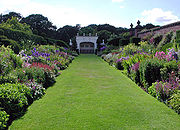
Herbaceous border
Encyclopedia

Perennial plant
A perennial plant or simply perennial is a plant that lives for more than two years. The term is often used to differentiate a plant from shorter lived annuals and biennials. The term is sometimes misused by commercial gardeners or horticulturalists to describe only herbaceous perennials...
herbaceous plant
Herbaceous plant
A herbaceous plant is a plant that has leaves and stems that die down at the end of the growing season to the soil level. They have no persistent woody stem above ground...
s (plants that live for more than two years and are soft-stemmed and non-woody) arranged closely together, usually to create a dramatic effect through colour, shape or large scale. The term herbaceous border is mostly in use in the United Kingdom
United Kingdom
The United Kingdom of Great Britain and Northern IrelandIn the United Kingdom and Dependencies, other languages have been officially recognised as legitimate autochthonous languages under the European Charter for Regional or Minority Languages...
and the Commonwealth
Commonwealth of Nations
The Commonwealth of Nations, normally referred to as the Commonwealth and formerly known as the British Commonwealth, is an intergovernmental organisation of fifty-four independent member states...
. In North America, the term perennial border is normally used.
Herbaceous borders as they are known today were first popularly used in gardens in the Victorian era
Victorian era
The Victorian era of British history was the period of Queen Victoria's reign from 20 June 1837 until her death on 22 January 1901. It was a long period of peace, prosperity, refined sensibilities and national self-confidence...
. Hybridization and new imported plant species revolutionized the form of British gardens in the 18th and 19th centuries. In addition, the works of Gertrude Jekyll
Gertrude Jekyll
Gertrude Jekyll was an influential British garden designer, writer, and artist. She created over 400 gardens in the UK, Europe and the USA and contributed over 1,000 articles to Country Life, The Garden and other magazines.-Early life:...
, a British 20th century garden designer and prolific writer, popularized the use of the herbaceous border through a revival of the British cottage garden
Cottage garden
The cottage garden is a distinct style of garden that uses an informal design, traditional materials, dense plantings, and a mixture of ornamental and edible plants. English in origin, the cottage garden depends on grace and charm rather than grandeur and formal structure...
.

World War I
World War I , which was predominantly called the World War or the Great War from its occurrence until 1939, and the First World War or World War I thereafter, was a major war centred in Europe that began on 28 July 1914 and lasted until 11 November 1918...
this type of border became less popular in Britain as there was a shortage of labour to keep the gardens maintained. However, there are still some celebrated examples in British gardens.
The world's longest herbaceous border at 215-metres (705 ft), is according to the Guinness Book of Records at Dirleton Castle
Dirleton Castle
Dirleton Castle is a medieval fortress in the village of Dirleton, East Lothian, Scotland. It lies around west of North Berwick, and around east of Edinburgh...
, East Lothian
East Lothian
East Lothian is one of the 32 council areas of Scotland, and a lieutenancy Area. It borders the City of Edinburgh, Scottish Borders and Midlothian. Its administrative centre is Haddington, although its largest town is Musselburgh....
, Scotland.

